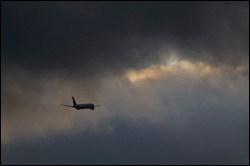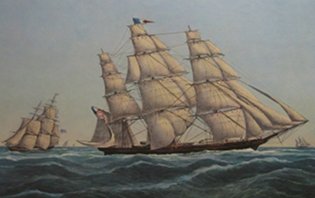 I suppose there's an irony here somewhere:
I suppose there's an irony here somewhere:
The most puzzling airline disaster in history has the most befuddling answer in the history of airline disaster solutions.
In brief: In 2009, in one of the most modern airliners ever built, Air France 447 took off from Rio in Brazil and was safely on its way to Paris, last contacting land while partway over the Atlantic.
And then it disappeared.
A few months later, the PBS show 'Nova' put together a team of experts to figure out what most likely happened. They had some serious heavyweights on board, like a guy who took part in the investigation of the tragic, final flight of the SST, and a guy who worked on what was considered the 'most puzzling crash in history' of its day, Flight 800 out of New York, which inexplicably blew up just off the coast, later traced to faulty wiring in a fuel tank.
But at least the Flight 800 team had little clues to work, like "where it went down".
As referred to, say, if it went down.
Because of the curvature of the earth, cross-Atlantic flights always go off radar at some point, and it was only hours later when it didn't show up on African radar that the alarm was even sounded. If a small electronic monitor box hadn't automatically sent a quick 'update' to headquarters via satellite link somewhere between 1 and 15 minutes before the crash, they would have been totally clueless where it ended up, and even then they just had its last known location and were forced to consider where the wreckage could be spread over hundreds of square miles of open ocean. And in 15,000 feet of water.
And they eventually did find it.
Black boxes, befuddlement, and all.
There were two main factors that made the whole event so puzzling:
1. The air speed indicators are small tubes that project outside the aircraft. There are three of them for redundancy and they're electrically heated so they won't ice up. Yet that last electronic burst indicated that, indeed, the uncloggable tubes had clogged, which automatically turns off the autopilot.
2. But this is no cause for alarm because all airplanes have a standard configuration that automatically puts them in level flight at the correct speed, in this case the engines at 85% thrust and the nose up 5 degrees. Keep the wings level, hope your compass still works, and you're good to go.
But the whole concept of not paying enough attention to the power and attitude settings made no sense, whatsoever, because the captain was a seasoned old veteran with two able crewmen to back him up.
Adding to the mystery is that while very few pieces were recovered, there were enough that they could determine the plane was in one piece and fairly level when it hit the water, which rules out any kind of mid-air catastrophe. From the evidence, it appeared the crew was in some semblance of control until the very end, which would also explain why no call for help was issued.
So there was zero reason for the crash.
A recap from the end of the Nova documentary follows, which mentions the two main points, above:
1. Ever heard of 'super-cooled water'? It's a bizarre physical phenomenon that occurs when 100% purified water is cooled far past the freezing point, yet it remains a liquid because ice, on a molecular level, actually requires an initial bit of 'dirt' to form around. In a brief shot in the clip below, he's removed the cap from the super-cooled, still-liquid bottle, screwed it right back on and bonked the bottle. The micro-dust that gathered on the inside of the cap in the second it was off starts the freezing process. Running into a freak event like this could explain the clogged air speed indicators.
2. Okay, the uncloggable tubes got clogged, but so what? Here you have three experienced pilots flying one of the most modernized, digitized, electronicized, fly-by-wire-icized airplanes in history, so it's a little hard to come up with the old 'pilot error' dodge. In the following recap, they'll theorize that perhaps they were a little slow in applying the thrusters, thereby possibly initiating a stall, but they acknowledge that's kind of a long shot earlier in the piece, simply because they had loads of time to pull out of a stall, and it's only, like, the first thing they teach you at flight school.
But our aviation super sleuths gave it their best.
And, as I said on the documentary's page, it looked like they nailed it. Air speed and autopilot quit working, the crew runs into an unexpected ultra-violent storm, the plane's bouncing all over hell and gone, the computer's spitting out error message after error message, and somehow in all that chaos the thrusters and attitude were never set correctly and the plane slowly lost altitude and eventually went into the drink.
What other explanation could there be?
As for this quote from the above clip:
Aviation does not do well with unsolved mysteries.
I'd say this was well borne out when Air France [read: the French taxpayers] kept paying some high-tech, deep-water search rig to keep looking for the wreckage and, amazingly, two arduous years later, they found both it and the two black boxes.
And it certainly wouldn't be any surprise if the black boxes verified Nova's findings. Ultra-bad weather, three clogged air speed indicators, error messages left and right, chaos in the dark, bouncing cockpit, with the resultant inattention to the power and attitude. Result? A steady downward path to oblivion.
What other explanation could there be?
Well, there was one tiny little thing.
One possible contributing factor that the entire investigative team never even considered.
One lone factor that, had one of the team members dared to suggest it, he would have been laughed from the room, dropped from the team, and, ironically, driven from the agency in disgrace for 'total mental idiocy'.
Ironic, because that's exactly the factor he raised.
Also known as brain lock, brain freeze and brain fry in psychiatric circles. The fact that he just held it and held it and held it and never said a word until the very end simply staggers the mind.
You would certainly say it's befuddling.
And the fact that Airbus had both eliminated the yoke and disconnected the controls from each other made the biggest point of all. As was vividly shown, the range of the control handle is fairly short, and would certainly be hard to spot across a dark cabin in a bouncing airplane, but at least you'd have a chance of spotting its unnatural position glancing at your own (connected) handle.
Never mind that the brain freeze would have been impossible to miss if Airbus hadn't removed the conventional yokes for a more (delicate cough) 'modern' look.
And there you have it. The thousands of articles, the millions of words, the endless hours of speculation and conjecture, the hordes of money spent on research and investigation and documentaries and TV specials, the air time, the radio time, the newsprint and news site space, the pundits and writers and columnists and bloggers, all of them guessing away at the mystery...
And not one of them got it right.
That's why I thought the word 'befuddling' in the second paragraph of this article deserved a most in front of it.
The full transcript from the flight recorder with running commentary is here.
So, to sum up the last and final leg of ill-fated Flight 447, the reason it crashed is because the captain was out of the cockpit, the computer spit out some error messages, and one of the two junior crewmen panicked and suffered what's known as "brain lock" in medical circles, where his brain told his right hand that the last place it wanted the plane to go was down, so it reflexively pulled back on the handle to go up — whereupon the brain promptly forgot all about it and continued acting normally until the very end, when, surprised, it noticed the locked position of the right hand for the first time in minutes and called attention to it. Because the range of the handle is so short, being in the 'up' position wasn't noticed by the other co-pilot in the dark, bouncing cabin, and even the captain's return did no good because he, too, couldn't see the position of the still-clutched handle.
Brain fry killed Flight 447.
And no one guessed that.


 I suppose there's an irony here somewhere:
I suppose there's an irony here somewhere: